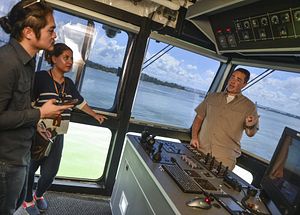Earlier this week, the deputy commanding general of U.S. Army Pacific met with Brunei’s second minister of defense. While the visit itself was just the latest interaction between the two sides, it nonetheless put the focus on some of the ongoing activity within the broader defense relationship between them.
As I have observed previously in these pages, the United States and Brunei – a small but nonetheless important player in Southeast Asia on a range of regional security issues in the Indo-Pacific region, from terrorism to the South China Sea – have an ongoing defense relationship, which includes various bilateral components such as ship visits, staff talks, and exchanges, along with other wider multilateral components as well such as the Southeast Asian state’s involvement in the Cooperation Afloat Readiness and Training (CARAT) exercise and the Southeast Asia Cooperation and Training (SEACAT) drills.
Over the past few years, both sides have continued to develop the U.S.-Brunei defense relationship amid wider domestic and regional developments. Indeed, just last August, we witnessed a new development in the bilateral relationship with the holding of Exercise Pahlawan Warrior under the segment of Pacific Pathways, which constituted the first bilateral training exercise of its kind between the armies of the United States and Brunei. This was in addition to other bilateral and multilateral defense engagements both sides have had, including the 17th iteration of SEACAT and the 26th biennial Rim of Pacific (RIMPAC) exercise.
This week, the defense relationship was in the spotlight again when John P. Johnson, the deputy commanding general of U.S. Army Pacific (USARPAC) was in Brunei. Johnson took up his current post back in July 2018, just after the U.S. Pacific Command (PACOM) saw its name changed to the U.S. Indo-Pacific Command (USINDOPACOM).
Johnson’s visit to Brunei included a series of interactions. He met with a range of officials including Brunei’s second minister of defense (the defense minister portfolio is still held by the country’s leader, Sultan Hassanal Bolkiah) and the commander of the Royal Brunei Armed Forces.
According to Brunei’s defense ministry (MINDEF), during Johnson’s meeting with the second minister of defense, both sides reviewed the status of their bilateral collaboration, including those specific to army-to-army ties as evidenced by the holding of Pahlawan Warrior last year.
Unsurprisingly, few additional specifics were publicly provided by either side on their private deliberations, including potential additional collaboration that may be in the works for the rest of 2019 and further out. Nonetheless, the evolution of the U.S.-Brunei defense relationship will continue to be interesting to watch in the years that come amid wider domestic and regional developments and how both sides respond to them.

































